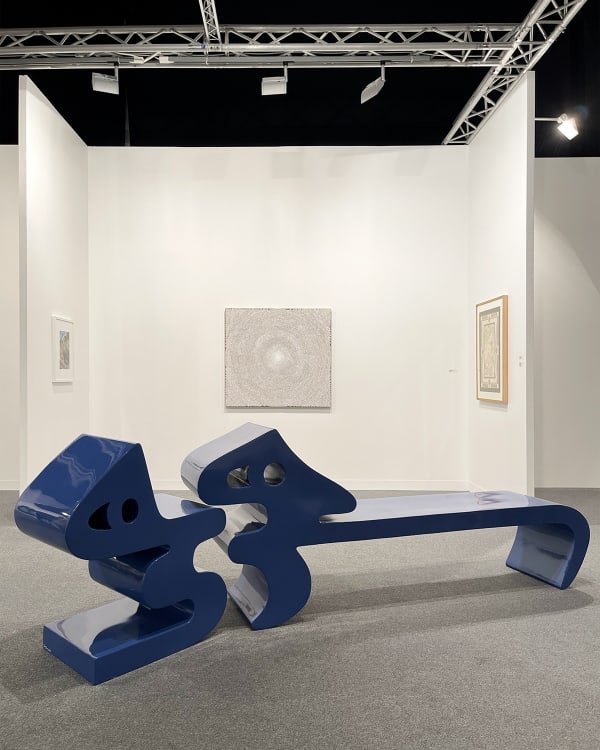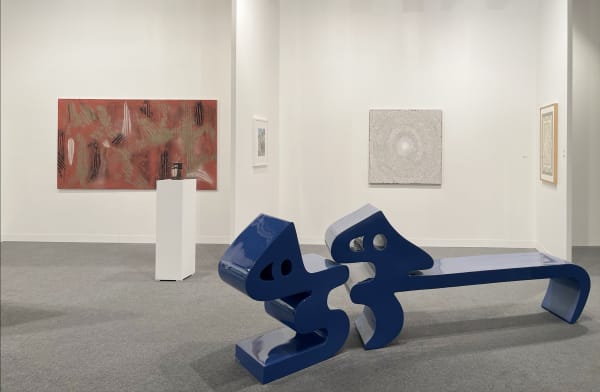Group Presentation: Abu Dhabi Art 2023
A Group Presentation of Works by Pooya Aryanpour, Fereydoun Ave, Raana Farnoud, Farah Ossouli, Farideh Lashai, Behjat Sadr, Koorosh Shishegaran, Parviz Tanavoli, Mohsen Vaziri Moghaddam, and Y.Z. Kami
At Abu Dabi Art 2023.
Booth: G13
Date: 20 - 26 November
Preview: 20 - 21 November
Location: Abu Dhabi
Address: Manarat Al Saadiyat
-
 Installation view of group presentation at Abu Dabi Art.
Installation view of group presentation at Abu Dabi Art. -
 Installation view of group presentation at Abu Dabi Art.
Installation view of group presentation at Abu Dabi Art. -
 Installation view of group presentation at Abu Dabi Art.
Installation view of group presentation at Abu Dabi Art. -
 Installation view of group presentation at Abu Dabi Art.
Installation view of group presentation at Abu Dabi Art. -
 Installation view of group presentation at Abu Dabi Art.
Installation view of group presentation at Abu Dabi Art. -
 Installation view of group presentation at Abu Dabi Art.
Installation view of group presentation at Abu Dabi Art. -
 Installation view of group presentation at Abu Dabi Art.
Installation view of group presentation at Abu Dabi Art. -
 Installation view of group presentation at Abu Dabi Art.
Installation view of group presentation at Abu Dabi Art. -
 Installation view of group presentation at Abu Dabi Art.
Installation view of group presentation at Abu Dabi Art. -
 Installation view of group presentation at Abu Dabi Art.
Installation view of group presentation at Abu Dabi Art. -
 Installation view of group presentation at Abu Dabi Art.
Installation view of group presentation at Abu Dabi Art.
Dastan is pleased to announce its participation at Abu Dhabi Art 2023 with a presentation of works by Pooya Aryanpour (b. 1971), Fereydoun Ave (b. 1942), Raana Farnoud (b. 1953), Farah Ossouli (b. 1953), Farideh Lashai (1944 – 2013), Behjat Sadr (1924 - 2009), Koorosh Shishegaran (b. 1940), Parviz Tanavoli (b. 1937), Mohsen Vaziri Moghaddam (1924 - 2018), Y.Z. Kami (b. 1956). The 15th edition of the Abu Dhabi Art will occur from 20 to 26 November 2023.
Pooya Aryanpour is one of his generation’s most renowned artists and university lecturers. His work focuses on creating mystery and suspense, exploring subject material rooted in the traditions of Iranian culture, symbolism, schools, and styles of narration, storytelling and folklore, Persian calligraphy schools, and their impact on artistic traditions, architecture, and painting. In his three-dimensional pieces, he combines architectural practices, sculpting, and painting inspired by traditional Iranian ornamentation techniques such as mirror-work (Ayine-Kari). He has adapted these to his vision through diverse modern approaches and procedures. Using such techniques, these sculptural pieces often take the observer beyond their physical boundaries as they create wide reflections that lead to plays of light, lines, and forms that create a sensory presence.
Fereydoun Ave has been an influential figure in the Iranian contemporary art scene. Over the past five decades, he has taken on many roles as an artist, designer, art director, collector, curator, gallerist, and art patron. Ave’s practice is a freehanded engagement with a personal ethos informed by more prominent cultural influences. He ceaselessly reflects on his relationship with age, myths, plants, elements, seasons, moods, and heredity. He takes inspiration from the art of Iran, which tends to use the entire canvas surface, and the Western penchant for minimalism, which leaves large swaths unattended. Fereydoun Ave's joint projects with artists, galleries (including Dastan), and institutions are integral to his practice, reflecting his role as a curator, gallerist, and collector.
Raana Farnoud has experimented with a broad spectrum of techniques, themes, and styles in painting over more than five decades. From naturalistic representation to abstraction, she has been inspired by her surroundings, such as desert landscapes, people, encounters, and the forms within the natural environment. Her unique technique and palette often transcends her compositions beyond time and space, transitioning into a contemplative state. Raana Farnoud’s work is currently presented in Art Jameel’s “Some Seasons: Fereydoun Ave and the Laal Collection, 1959–2019”. The Carnegie Museum of Art initially conceived the Laal Collection for the 58th Carnegie International.
Over the course of his career, Y.Z Kami has created work spanning a variety of mediums: Painting, drawing, collage, and sculpture. He explores concepts such as the material and the spirit, the outer and the inner, permanence and ephemerality. Kami’s “Dome” series references holy sites and sacred architecture through his rendition of geometric forms and his delicate palette. The paintings depict an eternal sense of dynamism and movement, spiraling into a center. The Museum of Modern Art (MoMA) acquired two works –"Messenger IV" (2022) and "Untitled (Head)" (2017)– by Y.Z. Kami in 2022.
Farah Ossouli is known for her contemporary interpretation of Persian miniatures. She is one of the first artists to appropriate ‘miniature painting’ as an authentic, personal, and artistic expression, portraying women’s lives and realities. Her work draws on her wide-ranging background, experience, and experimentation with painting, photography, film, animation, graphic design, literature, and theater. In her practice, she explores and depicts poetry delicately and contemplatively. Ossouli combines intricate gouache paintings with poetry, taz’hib illuminations, and subject matters that explore gender, media, identity, war, and politics. Recently, Skira published “Farah Ossouli, Burning Wings: Last Four Decades” (2023), an extensive monograph on the artist and her career.
Farideh Lashai was an Iranian contemporary artist known for her diverse work spanning painting, drawing, and video art. Born in Rasht, Iran, Lashai began her artistic career in the 1960s and gained recognition for her contributions to the Iranian art scene.
Her works often explore themes of memory, identity, and the human condition. Lashai's later years saw a shift towards multimedia installations, and she became internationally acclaimed for her innovative approach to art. Notably, her video installation "When I Count, There Are Only You... But When I Look, There Is Only a Shadow" gained widespread attention. Lashai's legacy endures as she continues to be celebrated for her significant impact on contemporary art in Iran and beyond.
Behjat Sadr is known as one of the pioneers of Modern Iranian painting who revolutionized long-standing traditions to introduce novel renditions. Sadr’s legacy and influence stand firmly in the present. Her paintings explore techniques and experiments in creating layers, texture, depth, volume, and geometry. Sadr’s approach to abstraction and her studies of styles and techniques, especially in how she perceives and portrays space and perspective, led to some of her most iconic compositions. Superimposition, collage, controlled yet fluid brushstrokes, the depiction of frames within frames, the separation of the outside versus the inside in landscapes, the representation of movement and stillness, and progressive experimental approaches to painting are among the significant aspects of her practice. The upcoming year marks 100 years since Behjat Sadr’s birth.
Koorosh Shishegaran has developed several different bodies of work that can be roughly categorized into two distinct periods: his pre-1980s political and conceptual works and his later works, which include linear and abstract paintings. His paintings, composition, and execution resemble the styles, techniques, and movements found in the rich traditions of Persian calligraphy. Shishegaran’s brushstrokes resemble the movements and impressions of the reed pen. The artist creates a dynamic sense of volume and depth through repetition, limited tonal gradients, controlled brushes, and delicate renditions.
Many scholars and art historians consider Parviz Tanavoli as one of the key figures and innovators in the practice and scope of modern Iranian sculpture. As a pioneer within the Saqqakhaneh school, one of the most prominent movements in Iran’s modern neo-traditionalist art, he has introduced new material in this domain. His pieces have been consistently among the most exhibited and discussed works of Iranian art. His practice and innovative approaches have been instrumental in introducing novel ideas, techniques, and perspectives into the domain of modern Iranian sculpture. His extensive work has led to numerous museum shows, including at the British Museum, the Metropolitan Museum, the Museum of Modern Art, Tate Modern, and many others, as well as book publications and articles. In addition to his artistic career, Tanavoli has extensively done research and editorial work on traditional Iranian crafts and art practices. The Tate Modern acquired two works –“Disciples of Sheikh San'an" (1974) and “Nightingale" (1974)– by Parviz Tanavoli in 1975. In 2023, the Vancouver Art Gallery (VAG) held a major exhibition titled "Parviz Tanavoli: Poets, Locks, Cages," which brought together over 100 works spanning Tanavoli's career over six decades six-decade.
Mohsen Vaziri Moghaddam, one of the pioneering artists of his time, was immensely fascinated with the interconnections of materials: he often combined techniques and substances into forms, surfaces, and structures that seemed to have been developed organically. Originating in his contemplations on the desert, his vision grew into a more expansive universe throughout his career. There are different layers and decisions under each material. In Vaziri Moghaddam’s work, each elaborates and pronounces the familiarity of his forms to the essence of his inspiration. The upcoming year will mark the 100 years since the birth of Mohsen Vaziri Moghaddam.
About Dastan: Dastan Gallery, founded to showcase and promote Iranian contemporary art globally, has become a dynamic platform supporting emerging and established artists. Renowned for cross-cultural dialogue, the gallery curates exhibitions transcending artistic boundaries, contributing to the global recognition of Iranian artists. With a network of spaces, including the main gallery in Tehran, Dastan's Basement for emerging art, +2 Gallery for established artists, and Parallel Circuit for large projects, the gallery transforms the traditional experience with its outdoor venue, the Electric Room. The recently opened Zaal Art Gallery in Toronto, established in 2023, marks Dastan's first permanent international space.

















